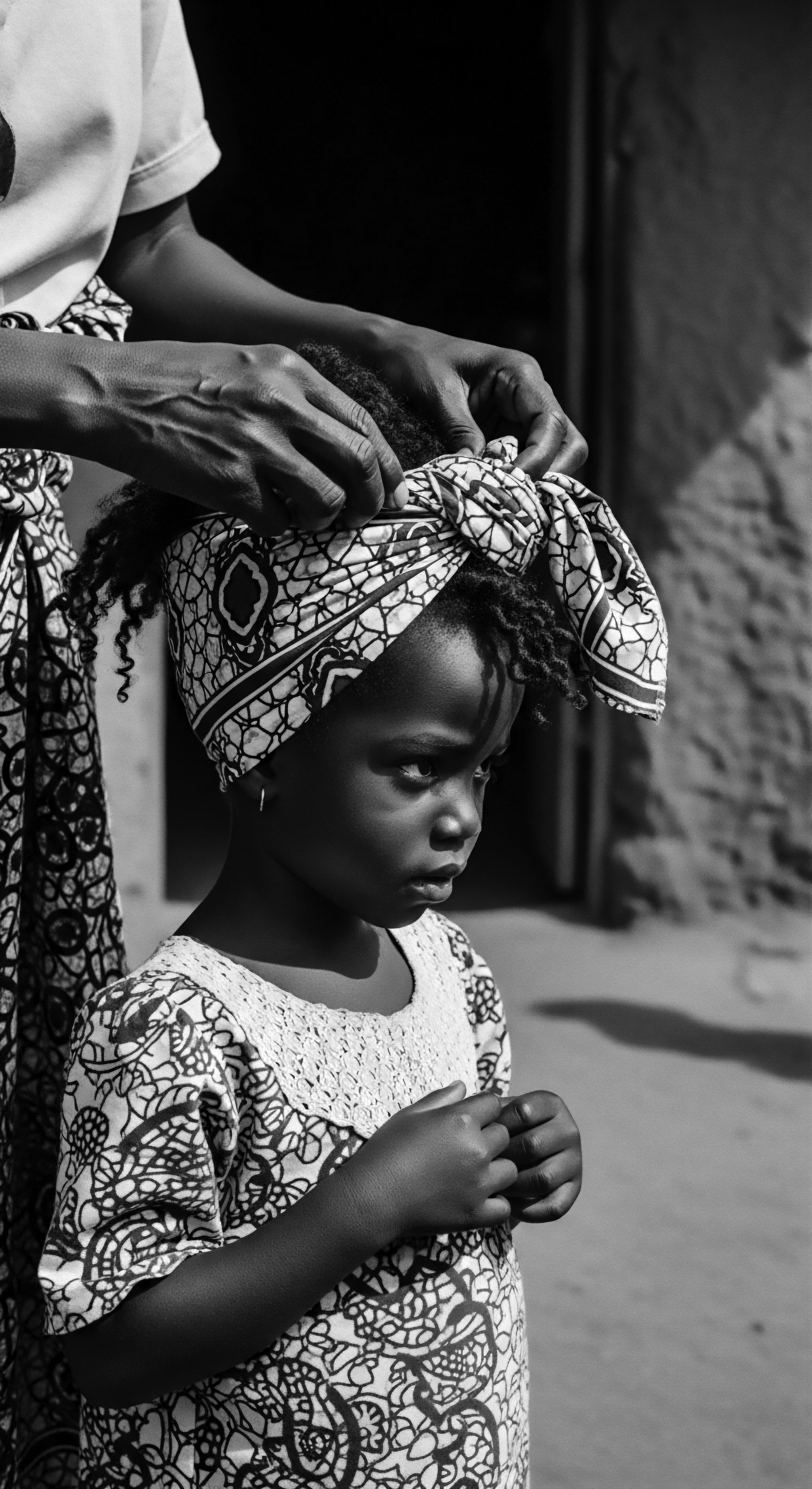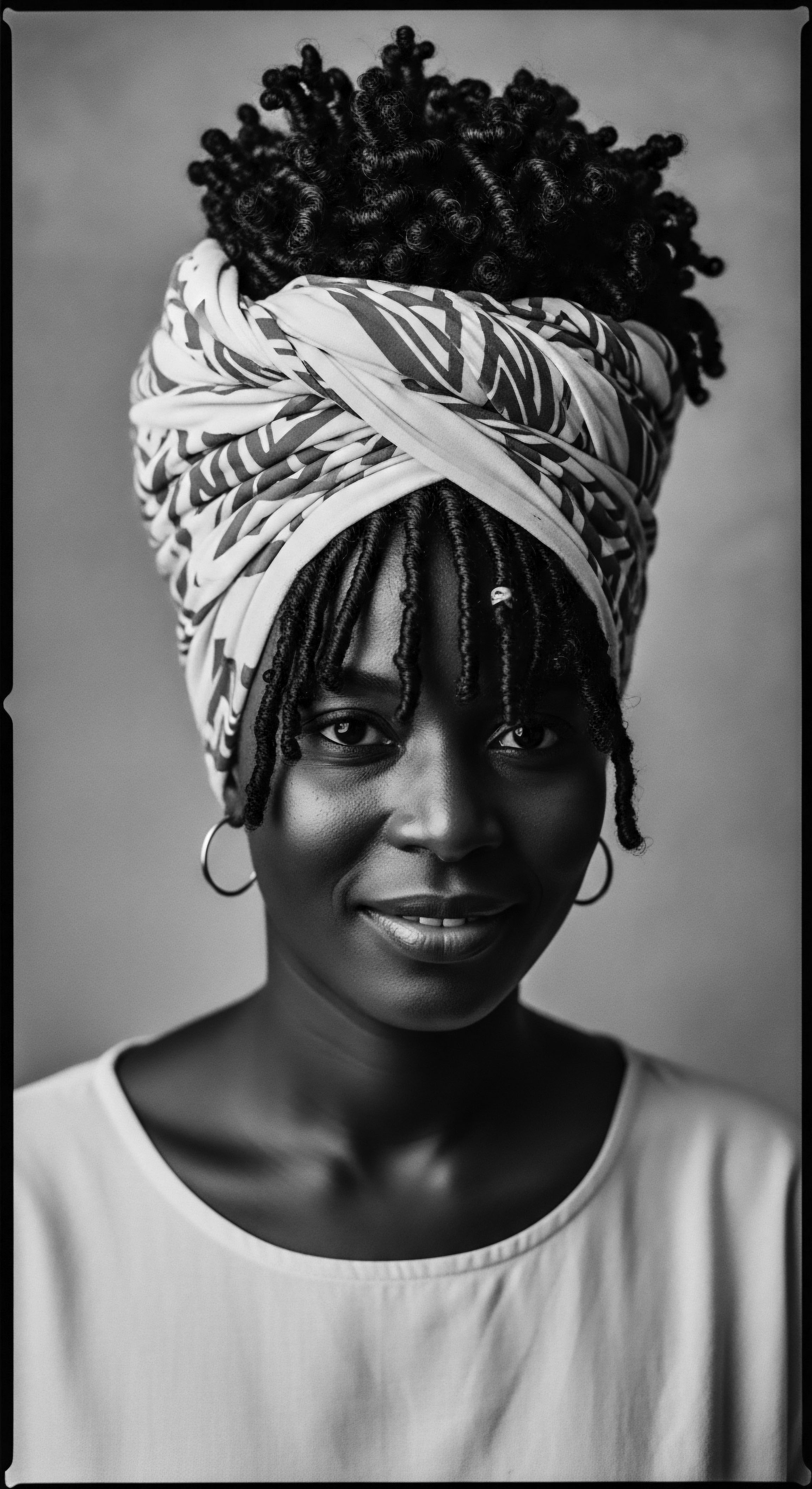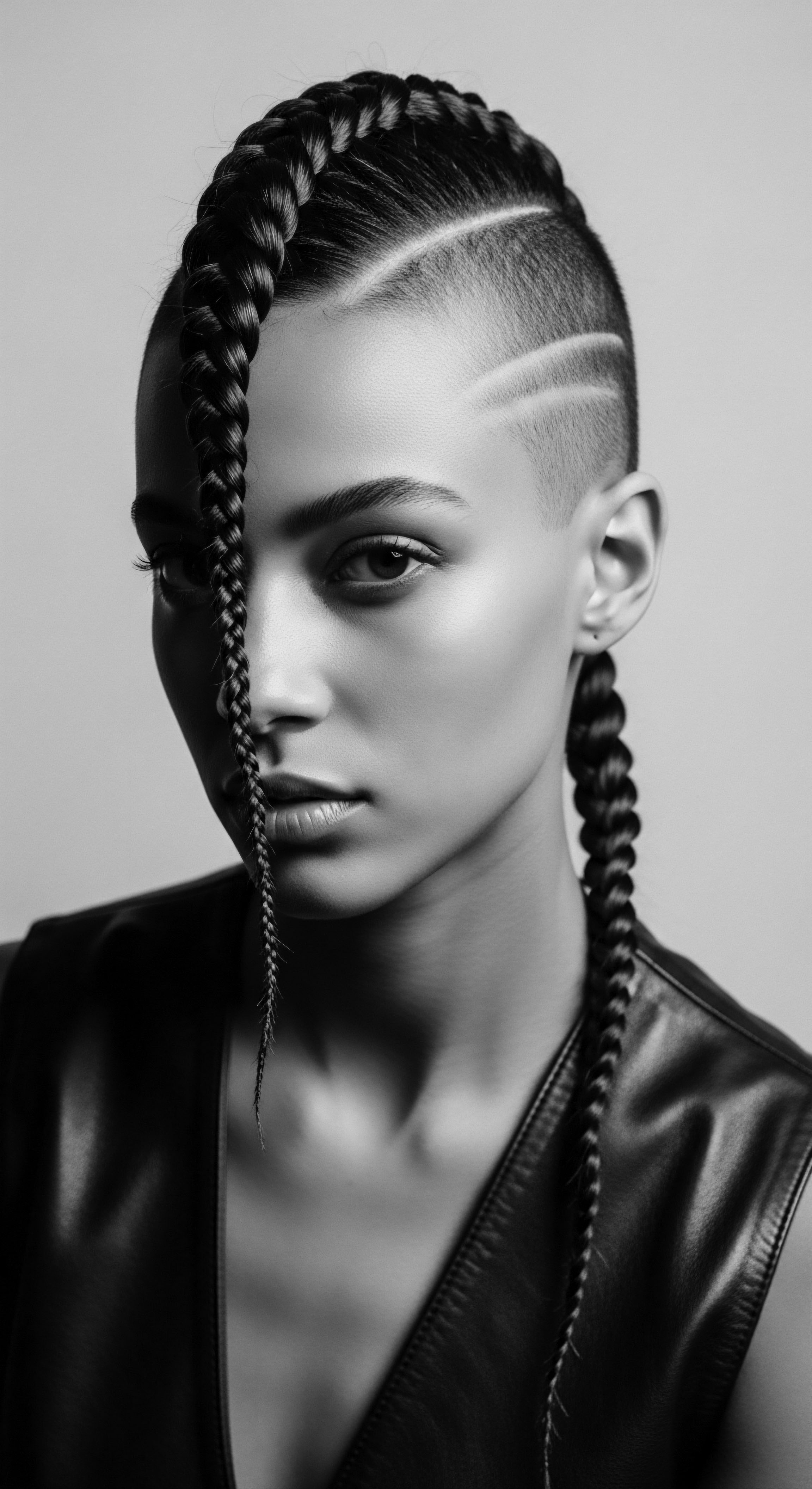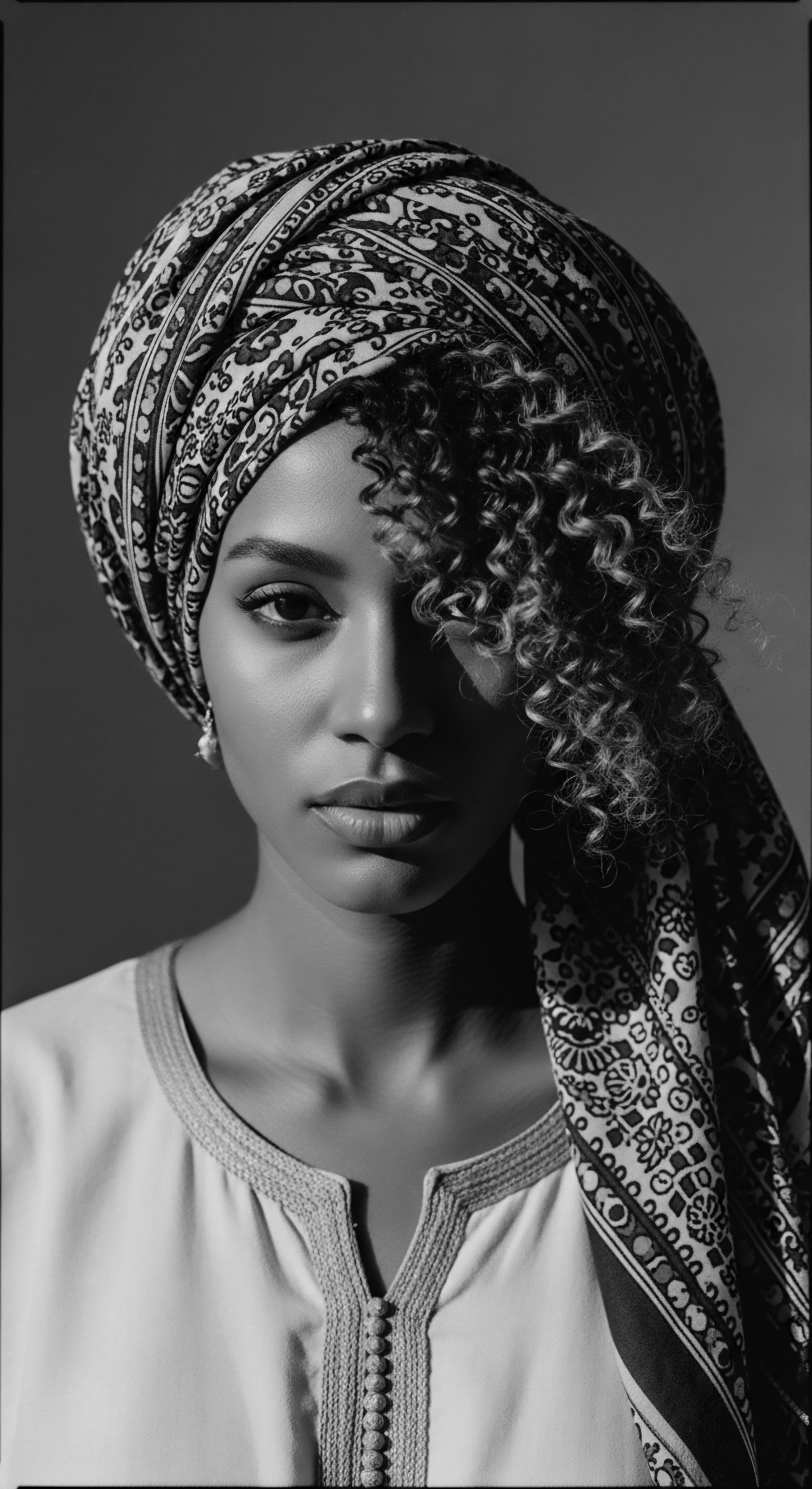
Roots
In the quiet hum of ancestral memory, where the wisdom of the earth meets the resilience of spirit, we find the genesis of every strand of hair. It coils, it kinks, it waves—a living testament to journeys spanning continents, centuries. For those whose lineage traces back to Africa, this hair carries not merely genetic code, but echoes of a profound cultural heritage, a heritage that colonial powers often sought to subdue. One such chapter, etched deep into the fabric of the American South, particularly New Orleans, reveals how oppressive decrees could inadvertently strengthen the very traditions they aimed to erase.
We speak here of the Tignon Laws, an edict that, in its very attempt to veil beauty, inadvertently illuminated the incandescent spirit of Black women, solidifying the headwrap’s place in textured hair heritage. Their hair, in its natural glory, had always been a crown, a canvas for storytelling, an articulation of identity and status. This inherent splendor, so visible in the vibrant streets of 18th-century New Orleans, provoked a response from those who feared its power.

Ancestral Crowns and Cultural Canvases
Before the arrival of colonial mandates, headwraps across the African continent were not mere adornments; they served as profound expressions of life, a visual lexicon understood within communities. From West Africa, where intricate wrapping methods signaled social standing or marital condition, to various regions where specific textiles communicated lineage or spiritual connections, the headwrap was a testament to a rich and complex system of meaning. The Gele of Yoruba women, for instance, could be a towering declaration of celebration, while other styles held deep spiritual significance. These traditions traveled across the vast, cruel expanse of the Middle Passage, resiliently clinging to the memories and practices of enslaved Africans.
Even in bondage, rudimentary head coverings continued as a practical necessity, shielding against sun and labor, yet still holding onto a whisper of their former cultural weight. This persistence set the stage for the Tignon Laws, a colonial attempt to dim a light that refused to be extinguished.
The headwrap, born from ancient African traditions, served as a dynamic language of identity, status, and spirit long before colonial decree attempted to stifle its voice.
The very structure of textured hair lent itself to these expressive styles. Its ability to defy gravity, to hold shape without elaborate internal supports, allowed for sculptural masterpieces that white women with straighter hair could not replicate. This physical reality underpinned much of the envy and fear that colonial authorities harbored. They perceived the elaborate coiffures of free women of color as a challenge to the established social order, a blurring of lines that threatened their carefully constructed racial hierarchy.
In Louisiana, which transitioned from French to Spanish rule, the growing population of free people of color presented a particular challenge to colonial control. These individuals, often of mixed African and European ancestry, had achieved a certain economic standing and presented themselves with a dignity that mirrored, and sometimes surpassed, that of their white counterparts. This social fluidity, particularly the attraction white men held for Black and mixed-race women, provoked a severe response from Governor Esteban Miró.

The Edict of 1786
In 1786, Governor Miró of Spanish Louisiana issued the Edict of Good Government, which came to be widely known as the Tignon Laws. These laws specifically mandated that women of African descent, whether free or enslaved, must cover their hair with a Tignon, a simple scarf or handkerchief, when appearing in public. The intent was explicitly stated ❉ to identify these women as belonging to the enslaved class, regardless of their freedom, and to curb their perceived social mobility and attractiveness. Virginia M.
Gould, a historian, suggests that Miró hoped these regulations would control women “who had become too light skinned or who dressed too elegantly, or who competed too freely with white women for status and thus threatened the social order” (Gould, in VICE, 2018). The laws were a direct assault on the visual markers of their liberty and beauty, aiming to reduce them to a subordinate status. Yet, this very act of suppression ignited a powerful, defiant creativity.
| Pre-Colonial Headwrap Function Status Marker ❉ Indicating social standing, marital condition, or wealth. |
| Colonial Intent of Tignon Laws Subordination Marker ❉ Visually linking free Black women to the enslaved class. |
| Pre-Colonial Headwrap Function Cultural Identity ❉ Expressing lineage, regional origin, or tribal affiliation. |
| Colonial Intent of Tignon Laws Cultural Erasure ❉ Attempting to strip visible signs of African heritage. |
| Pre-Colonial Headwrap Function Spiritual Significance ❉ Connecting to faith or protective beliefs. |
| Colonial Intent of Tignon Laws Demoralization ❉ Suppressing personal expression and dignity. |
| Pre-Colonial Headwrap Function Aesthetic Expression ❉ Showcasing beauty, artistry, and personal style. |
| Colonial Intent of Tignon Laws Diminishment of Beauty ❉ Hiding elaborate hairstyles to reduce attraction. |
| Pre-Colonial Headwrap Function The Tignon Laws sought to invert the inherent meaning of headwraps, but the spirit of resilience transformed their purpose. |
This historical context of the Tignon Laws must be seen against a wider backdrop of hair policing that stretched across the American South. Decades earlier, South Carolina’s Negro Act of 1735, and subsequent amendments in 1740, established dress regulations for both enslaved and free African Americans. These ordinances served to visually distinguish those without power from those who held it, a chilling precedent for the New Orleans edict.
The Tignon Laws were therefore not an isolated incident, but a specific regional manifestation of a broader, systemic effort to control Black bodies and identities through outward appearance. Understanding this layered history allows us to truly appreciate the depth of the resistance that would soon blossom in the face of such calculated oppression.

Ritual
From the stifling grip of oppressive laws, a different kind of ritual emerged—one forged in the crucible of defiance and born from a heritage of creativity. The Tignon Laws demanded concealment, yet the women of New Orleans, particularly the free women of color, responded with an artistry that transformed the mandated covering into a powerful statement of self. They did not simply comply; they transcended the intention of the law, turning an instrument of degradation into a canvas for their enduring spirit. This act, deeply rooted in ancestral practices of adornment and self-expression, shaped headwrap heritage in the American South in ways Miró could never have foreseen.

The Art of Defiance
The Spanish authorities decreed that Black women cover their hair with a plain handkerchief, supposedly to signify their lower social standing. However, the women of New Orleans possessed an innate understanding of aesthetic power. They sourced the most luxurious fabrics—silks, satins, and especially the vibrant, genuine Indian Madras cotton plaid cloth. These were not simple rags, but textiles of exquisite quality, often brought through global trade routes.
They then applied their ancestral knowledge of tying, knotting, and styling, inherited from generations of West African women who had sculpted fabric into elaborate crowns. The result was spectacular ❉ the tignon, instead of denoting inferiority, became a visually striking fashion statement, adorned with ribbons, brooches, jewels, and feathers. Each elaborate fold, every vibrant hue, every carefully placed embellishment was a silent, yet potent, act of resistance, asserting identity and beauty in the face of forced submission. Kathe Hambrick, a curator, noted that these women “owned it and made it a part of their fashion” (Hambrick, in VICE, 2018).
- Fabric Choices ❉ Luxurious silks, satins, and genuine Indian Madras cotton plaid, chosen for their richness and visual impact.
- Tying Techniques ❉ Ancestral methods of intricate knotting and sculptural wrapping, transforming simple cloth into artful constructions.
- Adornments ❉ Ribbons, brooches, jewels, and feathers, strategically placed to enhance beauty and signify status, directly defying the law’s prohibition on such embellishments in hair.

How Did Textured Hair Play a Role?
The inherent qualities of textured hair—its volume, its ability to hold shape, its natural elasticity—were, ironically, assets in this creative subversion. The very coils and kinks that the laws sought to conceal provided the perfect foundation for these elaborate wraps. The fullness of the hair underneath the fabric would have given the tignon structure and height, allowing for the dramatic, sculptural forms that became characteristic of this defiant style.
Women were not merely laying a flat scarf over their heads; they were building intricate, often towering, headpieces. This organic interaction between the hair’s natural properties and the fabric allowed for unparalleled artistic expression, making each tignon a unique work of art that highlighted, rather than diminished, the beauty it was meant to hide.
The Tignon Laws, intended to suppress, instead spurred an explosion of creative expression, transforming simple headscarves into defiant symbols of beauty and status through the ingenuity of Black women.
The story of the tignon becomes a powerful example of how Black women, throughout history, have used their hair and its adornment as a means of communication and self-assertion. The tradition of protective styling, deeply ingrained in textured hair care heritage, also finds an interesting parallel here. While the tignon was forced, it inadvertently served a protective function for the hair beneath, shielding it from the elements and allowing for longer periods between elaborate styling sessions. This practical aspect, intertwined with profound cultural and political meanings, cemented the headwrap’s dual role ❉ a symbol of external defiance and internal care.
| Historical Period Pre-Colonial Africa |
| Primary Meaning of Headwrap Cultural identity, social status, spiritual expression, beauty. |
| Connection to Textured Hair Styles built upon natural texture, showcasing its versatility and volume. |
| Historical Period Tignon Law Era (1786-1803) |
| Primary Meaning of Headwrap Forced subordination, transformed into active defiance, beauty, resistance. |
| Connection to Textured Hair Natural hair provided foundational volume for elaborate tignon structures. |
| Historical Period Post-Tignon Era & Beyond |
| Primary Meaning of Headwrap Symbol of pride, heritage, political statement, protective styling. |
| Connection to Textured Hair Continual embrace of natural textures, headwraps as a choice for care and expression. |
| Historical Period From mandated covering to chosen adornment, the headwrap’s meaning shifted, always rooted in the enduring spirit of textured hair heritage. |

A Resilient Legacy After Repeal?
Though the Tignon Laws were eventually repealed following the Louisiana Purchase in 1803, their spirit of resistance persisted. Black women, both free and formerly enslaved, continued to wear elaborate tignons as a chosen expression of their heritage and personal style. This cultural continuity, where a symbol of oppression became a symbol of pride, speaks volumes about the indomitable will of a people. The initial imposition might have been a dark cloud, but the vibrant, creative response transformed it into a shimmering, enduring light that guided the continuing journey of headwrap heritage in the American South.

Relay
The reverberations of the Tignon Laws extend far beyond the late 18th century, echoing through the subsequent generations of Black women in the American South and across the diaspora. These laws, though dismantled, left an indelible mark on the collective consciousness, shaping both the public perception and private rituals surrounding textured hair. The story of the headwrap, therefore, does not end with legal repeal; it continues to unfold as a testament to the enduring human capacity for adaptation, cultural preservation, and overt acts of self-love against societal pressures.

The Enduring Politics of Hair
The Tignon Laws cemented a precedent ❉ Black hair, in its natural state, was inherently politicized. This was a physical manifestation of deeper societal anxieties about racial hierarchy and the perceived threat of Black beauty and autonomy. The law’s attempt to strip visible markers of status and desirability from women of color is, unfortunately, a phenomenon that has persisted through various forms of hair discrimination. A 2023 study by the CROWN Coalition, for instance, found that Black Women’s Hair is 2.5 Times More Likely to Be Deemed Unprofessional Than Other Women’s Hair, significantly hindering advancement opportunities (CROWN Coalition, 2023).
This statistic underscores a continuous struggle rooted in the same Eurocentric beauty standards that motivated the Tignon Laws centuries ago. The act of wearing natural hair, or a headwrap, in contemporary society often becomes an act of quiet defiance, a statement of cultural pride that harks back to these historical battles.

How Did Suppression Become Self-Care?
In the shadow of laws like the Tignon Edict, Black women developed resourceful practices to care for and protect their hair. While forced, the consistent covering of hair with a tignon could have unintentionally served a protective function, shielding strands from environmental damage and maintaining moisture—a practice that aligns with modern understandings of textured hair care. This historical necessity may have reinforced the practicality of head coverings, contributing to their ongoing use even after the laws vanished.
Nighttime rituals, like wrapping hair with silk or satin scarves to protect it from friction and moisture loss, became commonplace, a tradition that persists today for preserving intricate styles and overall hair health. This convergence of practical care born from challenging circumstances and a deep understanding of natural hair’s needs became a core element of textured hair heritage.
- Protective Measures ❉ Headwraps offered a shield from the elements, reducing sun exposure and dust accumulation.
- Moisture Preservation ❉ Covering hair, especially with silk or satin, helped retain natural oils and hydration, crucial for textured strands.
- Style Longevity ❉ Headwraps extended the life of hairstyles, reducing the frequency of manipulation and thermal styling.
- Cultural Continuity ❉ Despite oppression, the practice allowed for the quiet continuation of traditional hair care and styling techniques.

The Unbound Helix ❉ A Legacy in Action
The power of the tignon as a symbol of resistance is perhaps best personified by individuals like Marie Laveau, the famed Voodoo practitioner of New Orleans. Though born shortly before the Tignon Laws were formally voided (in 1803), her public image, often depicted with an elaborate headwrap, cemented the tignon’s symbolic status. Laveau, known for her influence and societal connections, chose to wear her headwrap not as a sign of subjugation, but as a deliberate emblem of her power, identity, and connection to her heritage.
Her choice served as a living example of how the spirit of the tignon, transformed by the ingenuity of Black women, could transcend oppressive intentions and become a mark of distinction. This historical example powerfully illuminates the enduring legacy of turning constraint into a unique expression of cultural and personal strength, a narrative that continues to resonate in contemporary discussions about Black hair and beauty.
The Tignon Laws, though repealed, solidified a continuing legacy of hair policing, yet simultaneously galvanized Black women to transform forced concealment into a profound expression of cultural pride and self-care.
The journey of the headwrap, from a symbol of status in ancient Africa to a badge of forced inferiority, then a defiant statement, and now a cherished element of self-expression and cultural pride, reflects the complex and layered history of textured hair heritage in the American South. Contemporary movements, such as the CROWN Act, continue the fight for the right to wear natural hair without discrimination, drawing direct lines to the historical attempts to control Black women’s appearances through laws like the tignon edict. This historical context is vital, reminding us that for Black women, hair is rarely “just hair”; it is a deeply personal and political canvas, a living connection to ancestral wisdom, and a powerful tool for self-definition.
| Era/Context Pre-Slavery (Africa) |
| Headwrap Symbolism Identity, social status, spirituality, beauty. |
| Manifestation of Heritage Specific wrapping styles, fabric patterns, and adornments communicated belonging and lineage. |
| Era/Context Slavery & Tignon Laws |
| Headwrap Symbolism Forced servitude, transformed into resistance, dignity, defiance. |
| Manifestation of Heritage Elaborate tignons with luxurious materials and intricate ties as a visual subversion of oppressive mandates. |
| Era/Context Post-Emancipation & Civil Rights |
| Headwrap Symbolism Black pride, political consciousness, connection to African roots. |
| Manifestation of Heritage Reclamation of traditional styles, Afros, and headwraps as symbols of liberation and self-love. |
| Era/Context Contemporary Era |
| Headwrap Symbolism Cultural pride, self-care, fashion, professional identity, ancestral connection. |
| Manifestation of Heritage Continued use for protective styling, aesthetic expression, and as a statement against hair discrimination. |
| Era/Context The headwrap serves as a dynamic historical marker, constantly reinterpreted yet consistently affirming Black women’s cultural strength and resilience. |

What Challenges Do Black Women Still Experience Regarding Their Hair?
Even with the repeal of the Tignon Laws centuries ago, the policing of Black women’s hair persists in subtle, yet pervasive, ways. Many Black women and girls continue to face ridicule and discrimination based on their hairstyles in educational and professional settings. The concept of what constitutes “professional” hair often remains rooted in Eurocentric beauty standards, leading to implicit biases against textured styles like braids, locs, and natural afros.
This ongoing struggle is a direct echo of the historical attempts to control and diminish Black hair, proving that the battles fought by the women under the Tignon Laws continue in different forms today. The heritage of resistance, therefore, is not merely a historical footnote, but a living, breathing aspect of the textured hair journey.

Reflection
The story of the Tignon Laws and their unexpected legacy in shaping headwrap heritage in the American South stands as a luminous chapter in the living library of textured hair. It reminds us that beauty, heritage, and the very essence of self are not easily confined by decree or societal pressure. The deliberate artistry of Black women, their steadfast spirit in turning a symbol of intended shame into a beacon of defiance, reverberates through generations.
Each coil, each kink, each wave holds a memory of this resistance, a silent testament to a heritage that refuses to be diminished. The headwrap, once a forced veil, transformed into a chosen crown, continues to speak volumes about resilience, identity, and the enduring soul of a strand, forever connecting us to the wisdom and strength of those who came before.

References
- Byrd, A. D. & Tharps, L. L. (2014). Hair story ❉ Untangling the roots of Black hair in America (2nd ed.). St Martin’s Press.
- Caron, C. (2018). 5 Black women were told to golf faster. Then the club called the police. The New York Times.
- Crete, R. (1981). New Orleans and the Mardi Gras. Pelican Publishing.
- Gould, V. M. (2018). The Mulatta Concubine ❉ Terror, Intimacy, Freedom, and Desire in the Black Transatlantic. University of Georgia Press.
- Genovese, E. D. (1974). Roll, Jordan, Roll ❉ The World the Slaves Made. Pantheon Books.
- Klein, S. (2000). Creole ❉ The History and Legacy of Louisiana’s Free People of Color. Louisiana State University Press.
- Pettway, A. C. & Kongkaw, P. (2020). Existing While Black ❉ The Psychological Burden of Anti-Black Racism in the Liberal Arts. Westmont College.
- Tadele, S. (2020). Black women’s hair was once illegal. The Visibility Project.
- Wares, L. M. (1981). Dress and Undress in the Black Atlantic. Duke University Press.
